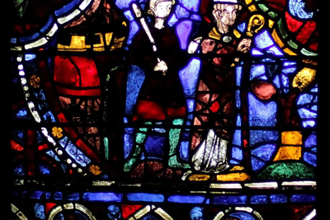Gospel in Art: Memorial of Saint Cecilia, Virgin & Martyr

Saint Cecilia, by Stefano Maderno, 1600 © Santa Cecilia in Trastevere, Rome / Christian Art
Source: Christian Art
Gospel of 22 November 2024
Luke 19:45-48
Jesus went into the Temple and began driving out those who were selling. 'According to scripture,' he said 'my house will be a house of prayer. But you have turned it into a robbers' den.'
He taught in the Temple every day. The chief priests and the scribes, with the support of the leading citizens, tried to do away with him, but they did not see how they could carry this out because the people as a whole hung on his words.
Reflection on the Sculpture
Today, we celebrate Saint Cecilia. Little is known about her life. Born in Rome in the late 2nd century AD, she suffered martyrdom around 230 AD under Roman Emperor Alexander Severus (reigned 13 March 222 - 22 March 235). According to legend, despite her vow of virginity, her parents forced her to marry a pagan nobleman named Valerian. During the wedding, Cecilia sat apart, singing to God in her heart, which later led to her being declared the patron saint of musicians. When the time came to consummate the marriage, Cecilia told her husband that an angel of the Lord watched over her, who would punish him if he violated her virginity but would love him if he respected it. According to legend, when Valerian asked to see the angel, Cecilia replied that he could do so if he went to the third milestone on the Via Appia and was baptised by Pope Urban I. Out of love for his wife, he followed her advice and then saw the angel standing beside her, crowning her with a chaplet of roses and lilies.
The marble sculpture of Saint Cecilia by Stefano Maderno, executed in 1599-1600, depicts Cecilia extending three fingers with her right hand and one with her left, symbolising the Trinity: one God in three persons (Father, Son, and Holy Spirit). The sculpture beautifully conveys the weight of a lifeless body. Notably, there is a thin but noticeable slash on Cecilia's neck, indicating her beheading.
Maderno's sculpture is said to replicate the way that Antonio Bosio (born in Malta in 1575, he was the founder of Christian archaeology in Rome and the first scholar to apply the study of ancient Christian texts to a systematic investigation of the Roman catacombs) described the saint at the moment of her discovery: 'namely on her side, uncorrupt, clothed in drapery, and with her veiled hair turned eerily towards the ground'. This fostered a legend that the sculpture was modelled on the very corpse of Saint Cecilia herself. However, it has since been concluded that the statue is Maderno's own composition, inspired by Bosio's words as well as studies of ancient sculptures.
LINKS
Gospel in Art: https://christian.art/
Today's Reflection: https://christian.art/daily-gospel-reading/luke-19-45-48-2024/


















